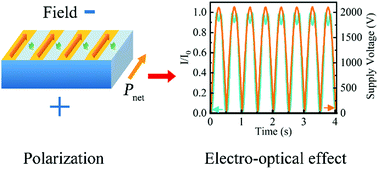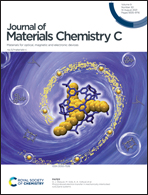Electro-optic modulation in a non-centrosymmetric antiferroelectric crystal†
Abstract
Electro-optic (EO) materials play a unique and crucial role in modern optical communication and laser science. However, EO materials with large EO coefficient are usually accompanied by serious piezoelectric ringing, which plays an important role in limiting their applications in high frequency and high voltage devices. It is difficult to find a balance between EO coefficient and piezoelectric coefficient. In this paper, we report a new EO crystal, K3Nb3B2O12 (KNBO), acquired from a non-centrosymmetric antiferroelectric (AFE) material. Its EO coefficient is determined to be 3.3 pm V−1, which is comparable with the performance of the commercial EO crystals BBO (2.5 pm V−1) and LGS (2.3 pm V−1). The KNBO crystal exhibits high transmittance (nearly 80%) and a wide optical transparency range (from 327 nm to 4.67 μm). Moreover, the KNBO crystal could effectively avoid piezoelectric ringing, due to a negligible piezoelectric coefficient. These balanced properties of the KNBO crystal favor potential EO applications. More importantly, this is the first demonstration of linear EO modulation in an AFE crystal. This work opens the door for the exploration of AFEs as potential EO materials, which simultaneously possess large EO coefficients and overcome piezoelectric ringing.



 Please wait while we load your content...
Please wait while we load your content...